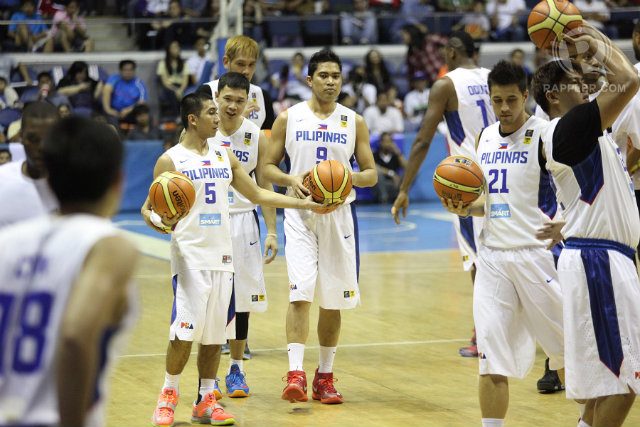SUMMARY
This is AI generated summarization, which may have errors. For context, always refer to the full article.

Don’t cry for Gilas Pilipinas.
It’s not dead.
It’s not buried.
It’s not gone.
The team fell short, sure.
No medals from Incheon, sure.
A collective record of 4 wins and 8 losses in its last two tournaments, sure.
Coach Chot calling out Marcus, sure.
Marcus scoring an own goal, sure.
There were certainly a lot of things to be disappointed about.
But Gilas Pilipinas was never just about the World Cup or the Asian Games. When the program started training under coach Rajko Toroman way back in 2009, the main goal was really to get the Philippines back on the world map of basketball by rising significantly in the FIBA rankings and bringing home victories in continental competitions.
So has the program, in the past 6 years, met those expectations?
Let’s see what they’ve brought home:
Championships:
2010 MVP Cup
2011 SEABA Championships
2012 Jones Cup
2013 Super Keung Sheung Cup
Second Place Finishes:
2010 Asian Basketball Association Club Championships
2011 Dubai Invitational Tournament
2013 FIBA Asia Championships
Third Place Finishes:
2010 Dubai Invitational Tournament
2011 Jones Cup
2014 FIBA Asia Cup
Fourth Place Finishes:
2010 FIBA Asia Cup
2010 Jones Cup
2011 FIBA Asia Champions Cup
2011 FIBA Asia Championships
2012 FIBA Asia Cup
Outside Top 4:
2009 FIBA Asia Champions Cup – 5th place
2010 FIBA Asia Champions Cup – 7th place
2010 Asian Games – 6th place
2014 FIBA World Cup – 21st place
2014 Asian Games – 7th place
We’ve definitely come a long way from the 8th place finish in the 2009 FIBA Asia Championships, not even making the second round in the 2007 FIBA Asia Championships, and those embarrassments during the Basketball Association of the Philippines (BAP) era.
The Samahang Basketbol ng Pilipinas (SBP), primary patron Manny Pangilinan, coaches Rajko Toroman and Chot Reyes, the members of their staff, the amateur and PBA players, and our naturalized guys (Andray Blatche and Marcus Douthit) are all directly responsible for all the success that the Gilas program has yielded.
No one person is directly, primarily, or solely responsible for all those achievements.
Equally, no one person is directly, primarily, or solely responsible for our World Cup heartbreaks and the debacle in the Incheon Asian Games.
This past week, many have spoken about the shortcomings of Gilas or, more specifically, its coach. Many have suggested, quite strongly I add, that coach Chot be fired. Some want coach Rajko back. Some want coaches Tim Cone or Yeng Guiao to return to the national team (Cone coached the Centennial Team in 1998 and Guiao did it in 2009). Some are suggesting a total revamp not only of the program but of the way basketball is done in the country (more on this in a future article).
Others, however, have stood behind the program (and coach Chot), saying that, despite the recent setbacks, by and large, Gilas has been a success and a model that can be even more successful given a few changes.
What cannot be denied, even by those on opposite sides of the fence, is that the Gilas program (including the Sinag, Energen-Pilipinas, and Batang Gilas teams) has definitely put basketball front and center again in the consciousness of Filipinos. Leagues like the UAAP and the PBA and media outfits have definitely benefitted, while the players themselves have enjoyed ballooned fan support since donning the national colors. For the first time in my memory, it seems there’s a semblance of continuity from the youth teams to the senior team, and there’s certainly a more deliberate effort to find Pinoy-rooted talent overseas and outside the megapolis that is Metro Manila.
We have also finally, almost absolutely, embraced the principle of having naturalized players willingly join our ranks. Generally speaking, this is no longer viewed as a copout, but, rather, a necessity to compensate for our inherent weaknesses. It is also a means to retain our competitive advantage, since many, if not most, countries around globe have adopted this same mindset.
And speaking of countries around the globe, a couple of indicators of Gilas really making its mark on world basketball are these: the Philippines winning the “Most Valuable Fans” Award in #Spain2014 and the Pinoys enjoying a lot of coverage from foreign press (e.g. Nick “Basketball Buddha” Bedard and Sergio Garcia-Ronras).
This, folks, as of now, is the big picture of Gilas. Gone are the days of hastily assembled teams sent to FIBA Asia tournaments for the sake of sending a team. Now, there are clearer ends, and more solid means to meet these ends. The results may not always be impressive, but at least we have made the whole world notice.
In Part 2, I’ll take a look at the hottest Gilas-related issue right now — the coaching.
– Rappler.com
Add a comment
How does this make you feel?
There are no comments yet. Add your comment to start the conversation.